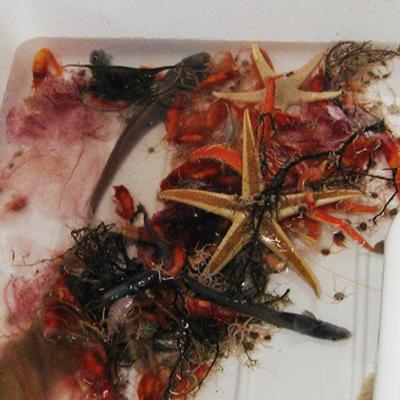Day 3
This far north there is daylight 24 hours a day. This means that sampling activities go on around the clock. Last night it was the macro biologists that drew the overnight sampling card.

Main content
| Date: | 3 August 2009 |
| Weather conditions: | foggy |
| Temperature (air / water): | 9.6 / 7.7 °C dew point = 9.1 |
| Wind speed: | 9.6 m/s = 18.6 knots |
| Wave height: | 2m |
| Location: | 72°N 14°E |
Daily report:
The plan for the night work focused on using a Mocness net (Mocness = Multiple Opening and Closing Net, with an Environmental Sensing System). The Mocness is a plankton / zooplankton net system. It may have as many as 20 individual nets Each net can be remotely opened and shut so the system can sample discrete patches of water in the water column. We are interested in the zooplankton communities found near the seafloor, under the methane plume, in the plume and over it.
While the Mocness was being set up we deployed a different kind of trawl. This brought up an interesting assortment of crustaceans and echinoderms (and a few other things!). The macro biology was quickly down to work sorting and preserving the samples for more detailed study back on land. Bernt found a number of amphipod samples for his thesis work.
We are studying the Håkon Mosby mud volcano, but we had no idea that it would be so muddy!! Yesterday's long core was quite soft and porous. This morning we tried short cores with the multi-corer. On the first try the instrument literally sank into the seafloor - too deep for the anaerobic methanotrophs that Ida is looking for just under the surface. The second try was successful from a collecting point of view, but the collected sediments are so soft that it is not easy to extract them from the core containers for study!
Rolf and Marvin have been looking at the echo sounder results to pick an area for water sampling with the large CTD. They would like to try to characterise the methane in the plume. The water has been getting steadily choppier, so we are grateful that the G.O.Sars has a drop keel that helps to minimize the effects of surface noise (waves slapping against the sides of the ship!), and improves the quality of the echo sound information.
Our visit to Håkon Mosby will finish with another ROV tour. We hope to go a little outside the volcano's perimeter to sample some methyl hydrate or frozen methane, which can be found just under the surface.
INTERESTING FACT: the Mocness nets are dyed black or dark blue to blend in with the water.
Click on a day below to access another report!
| Sun | Mon | Tues | Wed | Thurs | Fri | Sat |
| 1 | ||||||
| Day 1 | ||||||
| 2 | 3 | 4 | 5 | 6 | 7 | 8 |
| Day 2 | Day 3 | Day 4 | Day 5 | Day 6 | Day 7 | Day 8 |
| 9 | 10 | 11 | ||||
| Day 9 | Day 10 | Day 11 |
